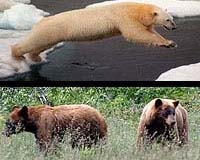Re: Grizzly bear back on the ES list
Smart: Environmental activism which is geared toward a real threat; for instance the killing of grizzly bears by people in the west. That's a direct link, and a direct response, which is smart policy. What is dumb is for this judge to claim that it has anything to do with global climate or global warming. In fact the temperatures in 2008 were colder, not warmer, than average.

Grizzlies, Back on the List Published: September 27, 2009
Last week, a federal district judge in Montana put the grizzly bears in the greater Yellowstone National Park area back on the endangered species list. Judge Donald Molloy said the Interior Department's 2007 rule removing the animal from the list — and the protections of the Endangered Species Act — had not provided adequately for the bears' survival. Although the department may appeal, the wiser course would be to devise a better plan.
The judge agreed that the recovery of the grizzly, whose numbers had climbed from some 200 at their lowest to around 600 at the time of delisting, had been remarkable. But the decision to delist — driven in part by the numbers and in part by the Bush administration's desire to declare a success — had provided only vague plans for maintaining bear populations and no specific responses in case they began to decline. It also relied too heavily on flawed state plans in Montana, Wyoming and Idaho.Further, Judge Molloy agreed with the environmental groups challenging the delisting that the Interior Department had failed to take into account the effects of climate change on the bears' food supply.
Warmer temperatures have caused an outbreak of mountain pine beetles, which have spread to higher slopes and killed millions of acres of whitebark pine trees, whose nuts are essential to the grizzly bear diet. This, in turn, has led the bears to forage elsewhere, increasing their contact with humans, including hunters. In 2008 alone, nearly 80 grizzlies were known to have died in the Yellowstone ecosystem.
Judge Molloy's ruling makes it clear that saving a species like the grizzly isn't just a matter of counting bears. It is also a matter of saving habitat. And where habitat has been degraded as rapidly as it has for the grizzly, extraordinary measures are required. Setting aside more habitat may be one of them. Whatever the answers, restoring the bears to the endangered species list is the essential first step to saving them — again.


0 Comments:
Post a Comment
<< Home